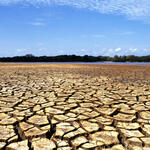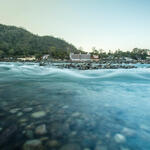- Date: 25 March 2022
- Author: Devon Leahy, Vice President of Sustainability at Ralph Lauren and Nicole Tanner, Freshwater & Food Transformation Manager, World Wildlife Fund
Hidden water is water that is not felt or seen in final products, but is required for almost every step of the production process. The water footprint of textile and apparel companies includes freshwater use throughout the phases of clothing production from growing cotton or other materials, to manufacturing and finishing the final garment. Therefore, water use needs to be effective and efficient across the value chain. By working to uncover where water is hidden within the value chain, the partnership between Ralph Lauren and World Wildlife Fund (WWF) is finding innovative ways to decrease water-related risk, preserve the resource, and benefit the environment and local communities.
- Date: 27 January 2021
- Author: Katherine Devine, Director of Business Case Development, WWF
The Possibility Is Closer than You Might Think
Many large companies have made environmental commitments to reduce embedded greenhouse gas emissions in the products they make or sell, yet are struggling to reach them. Scope 3 emissions pose a particular set of challenges—all the indirect emissions that occur both up and downstream in a company’s value chain, including from primary production, such as those emitted while producing milk on dairy farms. Within the food industry, supply chains are complex, with many ingredients going into diverse product portfolios. The dairy industry’s Net Zero Initiative¹ (NZI) has established the goal of reaching net zero GHG emissions by 2050 and has set a bold agenda to achieve this goal. Recent analysis conducted by The Markets Institute @ World Wildlife Fund—based on assumptions and data shared by stakeholders in the dairy industry—demonstrates that achieving net zero for large farms is possible with the right practices, incentives, and policies within five years. If businesses also step up to make investments and collaborate with dairy farmers in their supply chain, the potential to reach these goals can become even more tangible.
- Date: 16 October 2019
- Author: Kirsten James and Nicole Tanner
Chances are if you’ve bitten into a strawberry, blueberry, blackberry or raspberry lately, it was supplied by the world’s largest berry company, Driscoll’s. With products sourced from 21 countries, and sold in 48, Driscoll’s supplies one third of the global berry business.
But growing berries can be a water intensive proposition, with the added challenge that prime growing regions are often located in areas of high water stress. 80% of Driscoll’s acreage globally can be found in California and Mexico, regions which coincide with significant water risks to businesses and the communities in which they operate.
- Date: 17 October 2018
Investing Wisely in Water Requires Much Better Information
In advance of this week’s FT WWF Water Summit, Margaret Kuhlow, WWF’s Finance Practice Leader, urges the financial sector to get serious about water risk and calls for the disclosure of asset-specific location data to help realize water investment opportunities.
Business needs nature
WWF is in the business of saving life on Earth. And even though we don’t like to put a price on nature, we can.
Every year, the services that nature delivers, such as freshwater, pollination, soil fertility and climate regulation, are worth an estimated $125 trillion to the global economy. Yet as WWF’s forthcoming Living Planet Report 2018 will show, we are using up our natural capital faster than the Earth can replenish it. To sustain our current global levels of consumption, we would need 1.7 planets – but we only have one.
Troubled waters
In many countries, climate change and demographic pressure are set to worsen water shortages, jeopardize food production, put businesses at risk of drying and drowning assets, undermine the license to operate, and pollute and degrade natural ecosystems.
In WEF Global Risks Report 2018, four of the top five risks in terms of impact are environment-related, including water crises, which are both an environmental and human tragedy as well as a business risk.
Businesses are already feeling the effects of too little, too much, or too dirty water, either through a fall in revenue or an increase in capital expenditure.
The recent IPCC special report on Global Warming of 1.5°C shows the heatwaves, flooding and extended droughts we previously expected to see with a 2°C increase are likely to manifest through a 1.5°C change or less.
And while the proportion of the global population exposed to water stress could be 50% lower at 1.5°C than at 2°C, a 1.5°C increase will still expose 250 million urban residents to severe drought and increase flood risks by 100% by 2100.
With a 1.5°C change, freshwater reserves could fall by 9% in the Mediterranean, 10% in Australia and 7% in north-east Brazil while 800 million people in Asia who rely on the continent’s mountain glaciers for water could have to deal with a third less.
Globally, corporate respondents to the CDP Water Questionnaire indicated droughts, floods and water pollution cost business $14 billion in 2016 – a five-fold increase over 2015. Almost half expect a substantive change in business operations, and in 2017, reporting companies committed $23.4 billion to tackle water risks.
As we transition into a world of uncertain extremes, climate risks that manifest through water are real and growing – relevant to investment decisions we make not in a decade but today.
It is time for the finance, investment and insurance industries that support these businesses to assess and respond to water risk. Financial scenario analysis must account not only for carbon transition but also water-related risks and opportunities on the ground.
Bankability
Water-related risks, whether reputational, regulatory or operational, offer opportunities for profitable investment in areas such as irrigation, wastewater treatment, water supply, leakage prevention, flood defense, wetland restoration and clean technology.
At this week’s FT Water Summit, a new report from WWF, ING and BCG, Seizing the Water Opportunity, will demonstrate how blended private and public finance can help achieve SDG 6 on ‘water and sanitation for all’ and secure economies and bottom lines.
In fact, meeting the estimated $1 trillion investment needed for water infrastructure means private sector involvement is essential.
In Turkey’s Büyük Menderes basin, for example, textile manufacturers around Denizli are implementing cleaner production methods, reducing costs and cutting pollution in an area that is rich in biodiversity and a vital source of water for communities; and the government is planning a ‘green industrial park’ as part of a global initiative with the International Finance Corporation (IFC).
In Portugal, Lisbon’s water company, EPAL, cut water losses from more than 20% to less than 10% between 2005 and 2015, achieving total savings of $78.7 million for an initial investment of $2.3 million followed by $570,000 per year over the same period.
More broadly, freshwater is key for delivering almost all the SDGs and realizing economic opportunities in food and agriculture, energy and materials, cities, and health and well-being worth at least $12 trillion by 2030.
Disclosure, disclosure, disclosure
Supporting investments in bankable water projects can help companies gain a competitive advantage and benefit from lower costs, more resilient supply chains, and a better reputation with customers and regulators.
The key to realizing financial return is disclosure of meaningful data.
In June 2017, the Task Force on Climate-related Financial Disclosures (TCFD) issued recommendations for voluntary, consistent climate-related disclosures for investors, lenders, insurers, and other financial companies. Over 500 companies have so far expressed support for the recommendations, and the first reports are starting to appear.
Both the TCFD and CDP offer frameworks with which we can start quantifying material water-related risks that pose systemic risks to the financial system as serious as those driven by exposure to fossil fuels, as well as identifying opportunities for investment. And in many cases, water and climate risks and opportunities are related.
Better disclosure of material water and climate risks would make critical information available for financiers, investors and insurers, enabling them to assess risks more accurately and invest in business models that contribute to both water security and climate resilience.
Without access to additional, more specific and more standardized data, investments will languish in pilot and testing stages.
Location, location, location
We must evaluate exposure to water risk and identify opportunity for response at both basin and operational levels.
WWF’s Water Risk Filter will soon offer enhanced features, enabling financiers, investors and insurers to asses water risk, analyze TCFD-linked scenarios, estimate impacts on company value, and evaluate the appropriateness of mitigation measures.
But there is a crucial gap.
What the Water Risk Filter needs, and many investors lack, are asset-level location data on the specific whereabouts of operational and supply chain factories and farms. Some information, such as mining asset location, is openly available but assets of the Global 2000 are not comprehensively covered.
Without this information, context is lost. And without context, accurately evaluating both water risk and opportunity is impossible. This is the single biggest impediment to better integration of water risk within financial decision-making.
The TCFD has created momentum for disclosure. Now we need a clear signal from the financial sector that accounting for water risk is also ineluctable, and the provision and disclosure of high quality, consistent and specific asset-level data, fundamental.
The FT Water Summit will examine how companies can collaborate to solve shared water challenges and generate return on investments through water stewardship.
- Date: 26 October 2017
One year ago, Ceres and World Wildlife Fund (WWF) announced the conclusion of the first phase of the AgWater Challenge. Inspired by the “Feeding Ourselves Thirsty” analysis, the Challenge brought together companies in the food and beverage industry to reduce water risks in their supply chains and their impacts on local watersheds.
Representing over $123 billion in annual net revenue, these seven companies – Diageo, General Mills, Hain Celestial Group, Hormel Foods, Kellogg Company, PepsiCo and DanoneWave (formerly WhiteWave Foods) – leveraged the Challenge to review their programs and policies and share their experiences with each other. In total, they developed 18 new commitments to reduce water impacts associated with agricultural commodities along their supply chains.
But it didn’t stop there.
As discussed on the SIWI Sofa at World Water Week in August, we spent the last year continuing to work with the AgWater stewards to better understand the challenges and opportunities they experienced along the way.
One takeaway was clear: all AgWater participants realized the need to view water holistically. They agreed that water must be a fundamental integrated piece of a rich sustainability portfolio. And an integrated approach – one that includes not only water but also carbon, soil and social benefits – is more successful over the long-term and creates a much stronger business case with farmers and senior management.
AgWater participants PepsiCo and Diageo offered specific insights on lessons learned for companies starting out on their water stewardship journeys:
LESSON 1: Taking a Holistic Approach to Water Risk
PepsiCo, the global food and beverage company, understands the importance of taking a holistic perspective of water-related risk within its supply chain. When developing their global water strategy agenda, they looked across direct and indirect water use. Their detailed, comprehensive assessment process gave them an understanding of where they faced high water risk and a targeted view of local watersheds. The result was the realization that, in addition to quantitative targets on water use efficiency, wastewater quality, WASH, and watershed replenishment, the heart of the water strategy needed to be a goal to advocate for strong water governance in local watersheds. This goal is the centerpiece of PepsiCo’s program and the launching point for much of what the company seeks to accomplish on water stewardship.
LESSON 2: Large Scale Assessment Requires Flexible Approach
PepsiCo anchors its agricultural agenda behind the Sustainable Farming Initiative (SFI), a program to assess and support positive economic, social and environmental outcomes on farms where it directly sources agricultural products. Securing a quantitative assessment around the impact of their work when deploying across thousands of farmers proved challenging. To address this issue, they rely upon a combination of two approaches – a qualitative assessment and a theory of change impact assessment. The theory of change assessment will allow PepsiCo to systematically understand the impact of their efforts where opportunities to create positive change exist.
LESSON 3: Building the Business Case Is a Key to Success
Diageo’s water strategy includes a focus on their agricultural supply chain in water stressed markets. One of Diageo’s most important AgWater successes to date was achieving a better understanding of, and convening a coalition around, the value of providing access to clean water and sanitation in its agricultural growing areas in Africa.
LESSON 4: Relationships Come First
Earlier this year, Diageo launched a pilot project in Tanzania to develop a series of modules to help smallholder farmers manage water more effectively. The project was a collaborative effort with Water Witness International and German agency GIZ. It resulted from an Alliance for Water Stewardship assessment of a brewery supply chain there. Diageo confirmed that although smallholder farmers had clear water risks to deal with, they couldn’t approach them with an agenda focused solely around water.
To secure water in the face of growing demand, we need more companies to take meaningful actions like these. While the most recent “Feeding Ourselves Thirsty” report confirmed there has been progress — an average improvement of 10 percent in how companies score — since monitoring began in 2015, there’s still a long way to go. Through collaborative efforts like the AgWater Challenge, we can address corporate supply chain water risk for the benefit of people, planet and profits.
- Date: 29 August 2017
- Author: Daniella Foster, Sr. Director, Corporate Responsibility, Hilton
Just as water gives life to every person on our planet, the same is true for Hilton’s 5,000+ hotels: water is vital to their operations, supply chain, and their communities. In 2008, we started a journey to reduce water consumption in our network by 10 percent over five years. We met that goal a year early and eight years later we had almost doubled it with total reductions of 18.4 percent.
Fast forward to 2017 and we are proud to have celebrated World Water Day by announcing a new commitment to a comprehensive approach to water stewardship, covering our operations, supply chain, our communities and watersheds. This week we take another step on the journey and join other global organizations and leading water advocates at Stockholm’s World Water Week to share our lessons and progress.
To deliver on our new water commitment, we first had to create a baseline for our water stewardship efforts. In partnership with World Wildlife Fund’s Water Risk Filter, Hilton completed its first ever global water risk assessment for all of our hotels.
This assessment identified three high water risk areas in the United States, South Africa and China. Today we launch water pilot programs focused on training and empowering our Team Members on the water risks their communities are facing. Together we will work to mitigate those concerns by engaging in local programs to make a lasting difference.
Building on our strong operational management and existing water conservation efforts, our new water stewardship pilot programs will engage strategic suppliers beyond our operational boundaries. By extending our influence we can leverage our extensive partnerships and increase our ability to positively impact watersheds.
Hilton will continue to measure every drop of water consumed through our Corporate Responsibility performance measurement platform, LightStay. This enables us to collect and track water progress across all of our hotels, and allow us to refine and improve our efforts every step of the way.
Through our partnership with World Wildlife Fund, we are updating LightStay to provide hotels with information about their local risks and collect more locally-focused water data. This information will help us set contextual corporate water targets, and allow managers to make more informed water-related decisions. With better intel, we can continue to evolve and adapt our corporate approach to yield better results in our communities.
We have already made great progress in our journey, but we are just getting started. With World Water Week now in full swing, we are energized by the dialogue among our peers and partners. We hope that - before the end of the week - we will have unlocked the potential to achieve greater scale and impact in conserving and protecting the planet’s fresh water.
We believe that by helping our Team Members understand the role of water in our business and their role in its conservation, we can inspire our incredible teams on the frontlines of our hotels to be water stewardship champions, preserve our environment, and ultimately make a positive difference around the world!
###
- Date: 01 August 2017
- Author: Alexis Morgan, Water Stewardship Lead & Lindsay Bass, Manager of Corporate Water Stewardship, WWF
A win for (North American) water: Nestle Waters North America received recognition last week for its dedication to water stewardship. The company was awarded the continent’s first ever Alliance for Water Stewardship (AWS) certificate from SCS Global Services for a work site in California. This milestone represents a commitment to collective action at the local level to protect freshwater ecosystems and ensure sufficient water for people and nature. It also sends a public call to other businesses across the state and country to follow suit.
The concept of water stewardship is one that WWF has played a formative role helping to shape. Nearly a decade ago, when this journey began, a group of NGOs came together to discuss whether it would be possible to codify what “good and responsible water stewardship” looked like and to test the idea of certifying good water stewards. In 2009, the AWS was born, and has now grown to become a global system with over 75 members and certifications on four continents – Asia, Africa, Australia and now North America.
Back in 2007, the corporate discussions around water focused primarily on ‘water management.’ Fast forward ten years, and most companies are speaking in terms of ‘water stewardship.’ This shift is a critical one: it takes companies from an ‘in the fenceline’ (management) response that is focused on minimizing impacts on others, to a ‘beyond the fenceline’ (stewardship) approach that is focused on addressing shared water challenges to reduce impacts and mitigate risks.
However, while risk awareness and terminology are critical starting points, actions speak louder than words. AWS is a standard that can guide appropriate action, and a verification system that can ensure action and measure impacts. Certification ensures contextually-appropriate actions start with a company’s own operations and stretch across their supply chains. Certification provides an important stepping stone toward WWF’s ultimate goal – basin sustainability. In this regard, WWF is pleased to see Nestle Waters North America “walk the talk” and certify its sites to the AWS Standard, putting in place a process for continued action and community engagement on important shared water issues. However, though certification is a key milestone, there is still much work to do to ensure holistic basin sustainability.
In recent years, many companies have started to push back against certification calling it ‘burdensome’ and saying that proprietary codes of conduct are the way of the future. While standard systems must always listen to corporate challenges, in our opinion, standards and certification remain critical. Standards are the thin red line upon which many sustainability claims are made and supply chains respond. Unlike company codes, ISEAL standards, such as AWS, must enforce monitoring and evaluation of impacts. Furthermore, these multi-stakeholder systems also provide a common framework for supporters to rally behind. Certification is as much a testament to transparency and collaboration as anything.
Freshwater ecosystems remain under threat around the world and the ability to restore them is beyond any one actor. Working together, through collective action, is the only pathway to ensure that nature and people can flourish side by side. Water stewardship lays the foundation for such collaboration and those who certify to the AWS standard are making a statement of intent to not only address their water risks, but to address the shared water challenges facing communities across the globe.
WWF toasts the first (of many) AWS certificate(s) in North America!
- Date: 19 May 2017
- Author: Greg Koch, Senior Director, Global Water Stewardship, The Coca-Cola Company
Water is a finite resource—Earth has a fixed amount—but it is infinitely renewable. Since all water is renewed through natural processes, it means we—people, nature, business, farmers, and governments—always have and always will share the same water.
That level of sharing, through the continuous cycle of water, is global, and probably doesn’t feel personal to anyone. But sharing water also happens at the local level, everywhere, and this should be personal.
On June 5, we will co-host a conference, Sharing Water, with our partner World Wildlife Fund (WWF), along with the World Water Council (WWC). The event presents an opportunity to play a role in WWC’s official, regional process for North America in preparation for 8th World Water Forum—the world’s largest meeting on water, or as some refer to it: the “Olympics of water.” Discussions and output from the convening will be documented and provided to the organizers of the 8th Forum to help set the agenda and potentially contribute to its outcomes.
Our regional event will focus on a subset of themes for the 8th Forum, water and: development, finance, people, and ecosystems. Most important is the over-arching theme of sharing water, which is a powerful one.
Everyone and everything requires water in a given time and place, whether it’s at home to bathe your children, outdoors for recreational fun, in hand to quench your thirst, or on a farm to grow the food you consume. How much water you use and what you do to affect its quality matters to everyone in your community sharing the same water resource.
When you think of sharing water it can become easier to understand that we all need to be a part of paying for water infrastructure (financing), helping keep it clean (people), and conserving watersheds (ecosystems).
This concept drives our water stewardship program at Coca-Cola. Our business is mainly producing beverages and selling them to adjacent communities. So while we are certainly focused on sustainable use of water in our plants, being efficient, and making sure the water we discharge is clean, we also step out of our bottling plants to work with governments, communities, civil society, and even our competitors to help protect nature and address health issues through safe water access. We not only share the water, but also the responsibility of helping to protect and conserve it.
Our hope for the June 5 event is to build on this theme and help guide future discussions toward more collaborative solutions for water issues. We all need water and can’t look to any one actor to solve its challenges. Yes, it will take government, civil society, farmers, and industry, but it also takes you and me.
- Date: 17 November 2016
During World Water Week in Stockholm on Sept. 1, 2016, WWF’s Lindsay Bass, The Coca-Cola Company’s Greg Koch and LimnoTech’s Paul Freedman took a seat to participate in a recorded SIWI Sofa session, “Balancing Act: What Now for Corporate Water Goals?”
- Date: 25 August 2016

WWF and The Coca-Cola Company have been working together since 2007 to help conserve the world’s freshwater resources. We’ve made great strides in 2015 to help ensure healthy, resilient freshwater basins in our focal areas of the Mesoamerican Reef catchments in Mexico, Belize, Guatemala, and Honduras, and the Yangtze River in China.
Learn more about our progress in measurably improving environmental performance across Coca-Cola’s supply chain, integrating the value of nature into decision-making processes, and convening influential partners to solve global environmental challenges.
A Transformative Partnership to Conserve Water: Annual Report 2015








